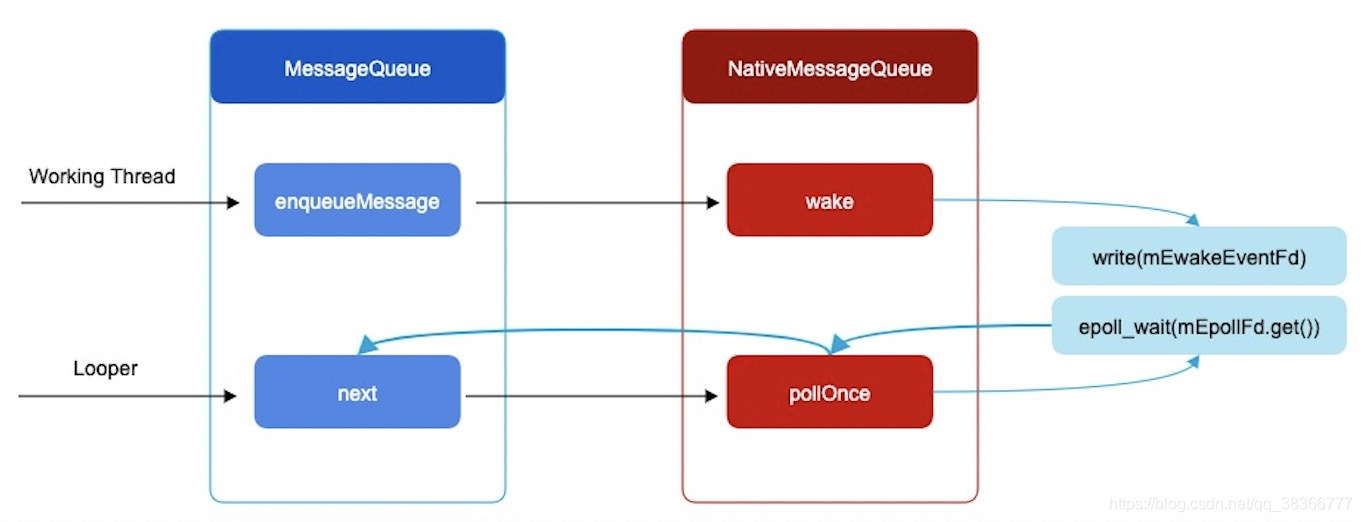4.5MessageQueue解析
目录介绍
- 01.MessageQueue作用介绍
- 1.1 主要是做什么
- 1.2 数据结构是什么
- 02.MessageQueue的定义
- 2.1 定义是什么
- 2.2 从哪里创建的
- 03.enqueueMessage()源码
- 3.1 解读源码流程
- 3.2 如何处理消息延时
- 04.next()方法源码分析
- 4.1 源码流程分析
- 4.2 处理延迟消息逻辑
- 05.延迟发送消息队列分析
01.MessageQueue作用介绍
1.1 主要是做什么
- MessageQueue,主要包含2个操作:插入和读取。
- 读取操作会伴随着删除操作,插入和读取对应的方法分别为enqueueMessage和next,其中enqueueMessage的作用是往消息队列中插入一条消息,而next的作用是从消息队列中取出一条消息并将其从消息队列中移除。
1.2 数据结构是什么
- 虽然MessageQueue叫消息队列,但是它的内部实现并不是用的队列。
- 实际上它是通过一个单链表的数据结构来维护消息列表,单链表在插入和删除上比较有优势。
02.MessageQueue的定义
2.1 定义是什么
- 通过源码我们可以知道,MessageQueue维护了一个消息列表。
- Message并不是直接添加到MessageQueue中,而是通过和Looper相关联的Handler来添加的。
- 在当前线程中可以通过调用Looper.myQueue()方法来获取当前线程的MessageQueue。博客
/** * Low-level class holding the list of messages to be dispatched by a * {@link Looper}. Messages are not added directly to a MessageQueue, * but rather through {@link Handler} objects associated with the Looper. * * <p>You can retrieve the MessageQueue for the current thread with * {@link Looper#myQueue() Looper.myQueue()}. */ public final class MessageQueue
2.2 从哪里创建的
- 既然
Looper对象已经由系统来为我们初始化好了,那我们就可以从中得到mQueue对象。public Handler(Callback callback, boolean async) { //获取 MessageQueue 对象 mQueue = mLooper.mQueue; } mQueue又是在Looper类的构造函数中初始化的,且mQueue是Looper类的成员常量,这说明 Looper 与 MessageQueue 是一一对应的关系private Looper(boolean quitAllowed) { mQueue = new MessageQueue(quitAllowed); mThread = Thread.currentThread(); }
03.enqueueMessage()源码
3.1 解读源码流程
- 源码如下所示
- 在Message的源码中定义了一个成员属性target,其类型为Handler。由上面enqueuMessage的源码,我们可以看到,当Message没有处理其的Handler或该Message正在被处理的时候,都不能正常进入MessageQueue,这一点也是很容易理解的。
- 当线程处于死亡状态的时候,Message会被回收掉,而不再进入该线程对应的MessageQueue中。否则,一切正常,enqueMessage就执行单链表的插入操作,将Message插入到MessageQueue中。
boolean enqueueMessage(Message msg, long when) { if (msg.target == null) { throw new IllegalArgumentException("Message must have a target."); } if (msg.isInUse()) { throw new IllegalStateException(msg + " This message is already in use."); } synchronized (this) { if (mQuitting) { IllegalStateException e = new IllegalStateException( msg.target + " sending message to a Handler on a dead thread"); Log.w(TAG, e.getMessage(), e); msg.recycle(); return false; } msg.markInUse(); msg.when = when; Message p = mMessages; boolean needWake; if (p == null || when == 0 || when < p.when) { // New head, wake up the event queue if blocked. //p为null(代表MessageQueue没有消息) 或者msg的触发时间是队列中最早的, 则进入该该分支 //when什么时候会等于0,在调用sendMessageAtFrontOfQueue时 msg.next = p; mMessages = msg; needWake = mBlocked; } else { //将消息按时间顺序插入到MessageQueue。一般地,不需要唤醒事件队列,除非 //消息队头存在阻塞,并且同时Message是队列中最早的异步消息 // Inserted within the middle of the queue. Usually we don't have to wake // up the event queue unless there is a barrier at the head of the queue // and the message is the earliest asynchronous message in the queue. needWake = mBlocked && p.target == null && msg.isAsynchronous(); Message prev; for (;;) { prev = p; p = p.next; if (p == null || when < p.when) { break; } if (needWake && p.isAsynchronous()) { needWake = false; } } msg.next = p; // invariant: p == prev.next prev.next = msg; } // We can assume mPtr != 0 because mQuitting is false. if (needWake) { //去唤醒消息队列所在的线程 nativeWake(mPtr); } } return true; }
3.2 如何处理消息延时
- 思考如何处理消息延时
- MessageQueue是按照Message触发时间的先后顺序排列的【也就是说会改变链表的顺序】,队头的消息是将要最早触发的消息。
- 排在越前面的越早触发,那我们现在应该了解到了,这个所谓的延时呢,不是延时发送消息,而是延时去处理消息,我们在发消息都是马上插入到消息队列当中。
- 插入完消息之后,怎么又保证在我们预期的时间里处理消息呢?
- 需要看一下next()方法。
04.next()方法源码分析
4.1 源码流程分析
- next方法源码如下所示
- 在 MessageQueue 中消息的读取其实是通过内部的
next()方法进行的,next()方法是一个无限循环的方法。博客 - 如果消息队列中没有消息,则该方法会一直阻塞,
- 当有新消息来的时候
next()方法会返回这条消息并将其从单链表中删除。
Message next() { // Return here if the message loop has already quit and been disposed. // This can happen if the application tries to restart a looper after quit // which is not supported. final long ptr = mPtr; if (ptr == 0) { return null; } int pendingIdleHandlerCount = -1; // -1 only during first iteration int nextPollTimeoutMillis = 0; for (;;) { if (nextPollTimeoutMillis != 0) { Binder.flushPendingCommands(); } nativePollOnce(ptr, nextPollTimeoutMillis); synchronized (this) { // Try to retrieve the next message. Return if found. final long now = SystemClock.uptimeMillis(); Message prevMsg = null; Message msg = mMessages; if (msg != null && msg.target == null) { // Stalled by a barrier. Find the next asynchronous message in the queue. do { prevMsg = msg; msg = msg.next; } while (msg != null && !msg.isAsynchronous()); } if (msg != null) { if (now < msg.when) { // Next message is not ready. Set a timeout to wake up when it is ready. nextPollTimeoutMillis = (int) Math.min(msg.when - now, Integer.MAX_VALUE); } else { // Got a message. mBlocked = false; if (prevMsg != null) { prevMsg.next = msg.next; } else { mMessages = msg.next; } msg.next = null; if (DEBUG) Log.v(TAG, "Returning message: " + msg); msg.markInUse(); return msg; } } else { // No more messages. nextPollTimeoutMillis = -1; } // Process the quit message now that all pending messages have been handled. if (mQuitting) { dispose(); return null; } // If first time idle, then get the number of idlers to run. // Idle handles only run if the queue is empty or if the first message // in the queue (possibly a barrier) is due to be handled in the future. if (pendingIdleHandlerCount < 0 && (mMessages == null || now < mMessages.when)) { pendingIdleHandlerCount = mIdleHandlers.size(); } if (pendingIdleHandlerCount <= 0) { // No idle handlers to run. Loop and wait some more. mBlocked = true; continue; } if (mPendingIdleHandlers == null) { mPendingIdleHandlers = new IdleHandler[Math.max(pendingIdleHandlerCount, 4)]; } mPendingIdleHandlers = mIdleHandlers.toArray(mPendingIdleHandlers); } // Run the idle handlers. // We only ever reach this code block during the first iteration. for (int i = 0; i < pendingIdleHandlerCount; i++) { final IdleHandler idler = mPendingIdleHandlers[i]; mPendingIdleHandlers[i] = null; // release the reference to the handler boolean keep = false; try { keep = idler.queueIdle(); } catch (Throwable t) { Log.wtf(TAG, "IdleHandler threw exception", t); } if (!keep) { synchronized (this) { mIdleHandlers.remove(idler); } } } // Reset the idle handler count to 0 so we do not run them again. pendingIdleHandlerCount = 0; // While calling an idle handler, a new message could have been delivered // so go back and look again for a pending message without waiting. nextPollTimeoutMillis = 0; } } - 在 MessageQueue 中消息的读取其实是通过内部的
4.2 处理延迟消息逻辑
- 如何处理延迟消息的获取
- msg != null 我们看下这部分,如果当前时间小于头部时间(消息队列是按时间顺序排列的),那就更新等待时间nextPollTimeoutMillis,等下次再做比较。
- 如果时间到了,就取这个消息并返回。如果没有消息,nextPollTimeoutMillis被赋为-1,这个循环又执行到nativePollOnce继续阻塞。
- nativePollOnce最终执行到的函数
- Looper.cpp:: pollInner。可以看到是由 epoll_wait来阻塞的。
int Looper::pollInner(int timeoutMillis) { ... // Poll. int result = POLL_WAKE; mResponses.clear(); mResponseIndex = 0; mPolling = true;//即将处于idle状态 struct epoll_event eventItems[EPOLL_MAX_EVENTS]; int eventCount = epoll_wait(mEpollFd.get(), eventItems, EPOLL_MAX_EVENTS, timeoutMillis);//等待事件发生或者超时,在nativeWake()方法,向管道写端写入字符,则该方法会返回; ... return result; }
05.延迟发送消息队列分析
- 消息队列如下所示

image
- 通过上述片段我们了解到
- 消息队列是按消息触发时间排序的
- 设置epoll_wait的超时时间,使其在特定时间唤醒,这里我们先计算当前时间和触发时间有多长,这个差值作为epoll_wait的超时时间。
- epoll_wait超时的时候就是消息触发的时候了,就不会继续堵塞,继续往下执行,这个线程就会被唤醒,去执行消息处理
其他介绍
01.关于博客汇总链接
02.关于我的博客
- github:https://github.com/yangchong211
- 知乎:https://www.zhihu.com/people/yczbj/activities
- 简书:http://www.jianshu.com/u/b7b2c6ed9284
- csdn:http://my.csdn.net/m0_37700275
- 喜马拉雅听书:http://www.ximalaya.com/zhubo/71989305/
- 开源中国:https://my.oschina.net/zbj1618/blog
- 泡在网上的日子:http://www.jcodecraeer.com/member/content_list.php?channelid=1
- 邮箱:yangchong211@163.com
- 阿里云博客:https://yq.aliyun.com/users/article?spm=5176.100- 239.headeruserinfo.3.dT4bcV
- segmentfault头条:https://segmentfault.com/u/xiangjianyu/articles
- 掘金:https://juejin.im/user/5939433efe88c2006afa0c6e
